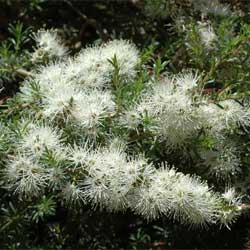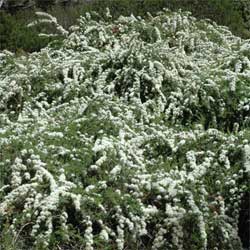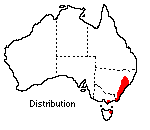Kunzea ambigua
 |
 |
Tick Bush
Kunzea ambigua or tick bush is commonly found growing on the coastal strip and adjacent plateaus of eastern Australia (New South Wales, Victoria, Tasmania), often forming dense thickets. This genus, which is of the family Myrtaceae, is confined to Australia and is closely allied to Leptospermum although it is readily distinguished by its long protruding stamens.
 In
nature K. ambigua is a shrub of variable growth habit reaching a height
of about 2-3 m in New South Wales regions where on sandstone and granite-based
soils it grows into a rather stiff, upright, spreading shrub with fibrous furrowed
bark. This form has masses of small creamy-white, honey-scented flowers borne
in heavy sprays. Masses of spreading stamens concealing the tiny petals give
the flowers a fluffy appearance. The flowering period varies between September
and early November.
In
nature K. ambigua is a shrub of variable growth habit reaching a height
of about 2-3 m in New South Wales regions where on sandstone and granite-based
soils it grows into a rather stiff, upright, spreading shrub with fibrous furrowed
bark. This form has masses of small creamy-white, honey-scented flowers borne
in heavy sprays. Masses of spreading stamens concealing the tiny petals give
the flowers a fluffy appearance. The flowering period varies between September
and early November.
The leaves, small and crowded (about 1 cm long) and narrow-linear in shape, are produced on short stalks. The seed capsules are distinctive, but remain on the plant only until the fruit matures. They are somewhat bowl-shaped, often with a rosy bloom. Capsules are divided into several compartments which open by radiating slits in the top to disperse their contents.
A superior form which has been growing successfully in the Australian National Botanic Gardens originated from Wilsons Promontory in Victoria. It has a diffuse, sprawling growth habit with stiff, slightly arching branches and appears to be much more floriferous than the NSW form. It may spread to at least 4 m and to a height of 1.5 m. A pink form of K. ambigua, the origin of which is obscure, is also under cultivation in the Botanic Gardens.
This species propagates readily from seed or semi-hardwood tip cuttings taken in late spring through to early autumn. To induce speedier results in striking cuttings a commercial rooting hormone may be used. Little maintenance is required other than an application of a complete fertilizer in early spring and light pruning and shaping to develop a compact, bushy shrub. A common pest is the webbing caterpillar which may be controlled by physical removal or by an application of a systemic insecticide.
Under cultivation K. ambigua grows into a handsome shrub which attracts numerous birds and colourful soldier beetles when in flower. It adapts to many situations and may be used as a background shrub, for screening or as a feature plant.
Text by ANBG staff (1978)
Name meaning: Kunzea ambiguaKunzea - after Gustave Kunze (1793 -1851), a German botanist and physician; ambigua - from the Latin, doubtful, uncertain (reason for name is obscure) |
![An Australian Government Initiative [logo]](/images/austgovt_brown_90px.gif)

